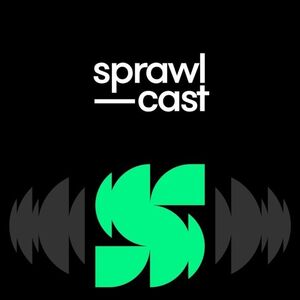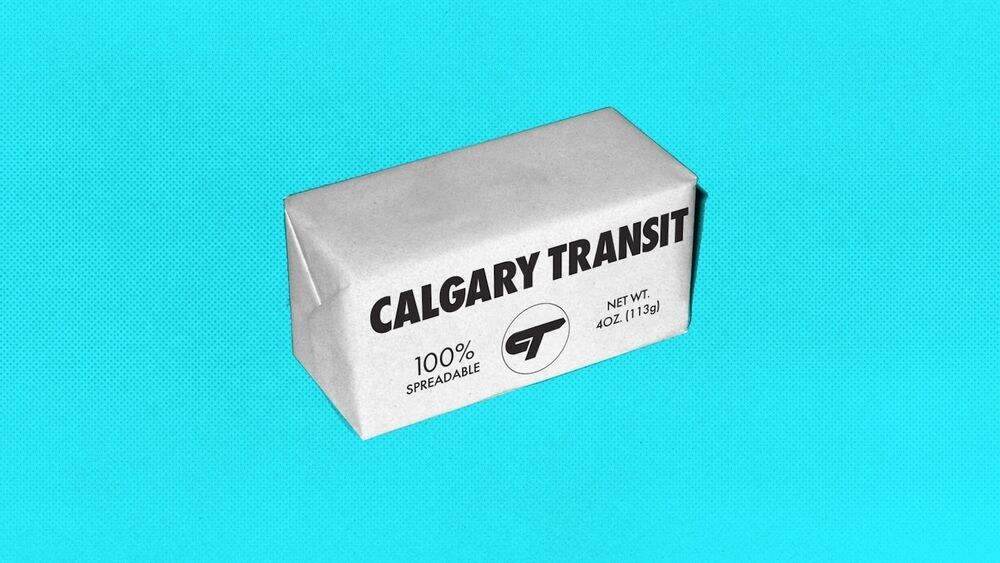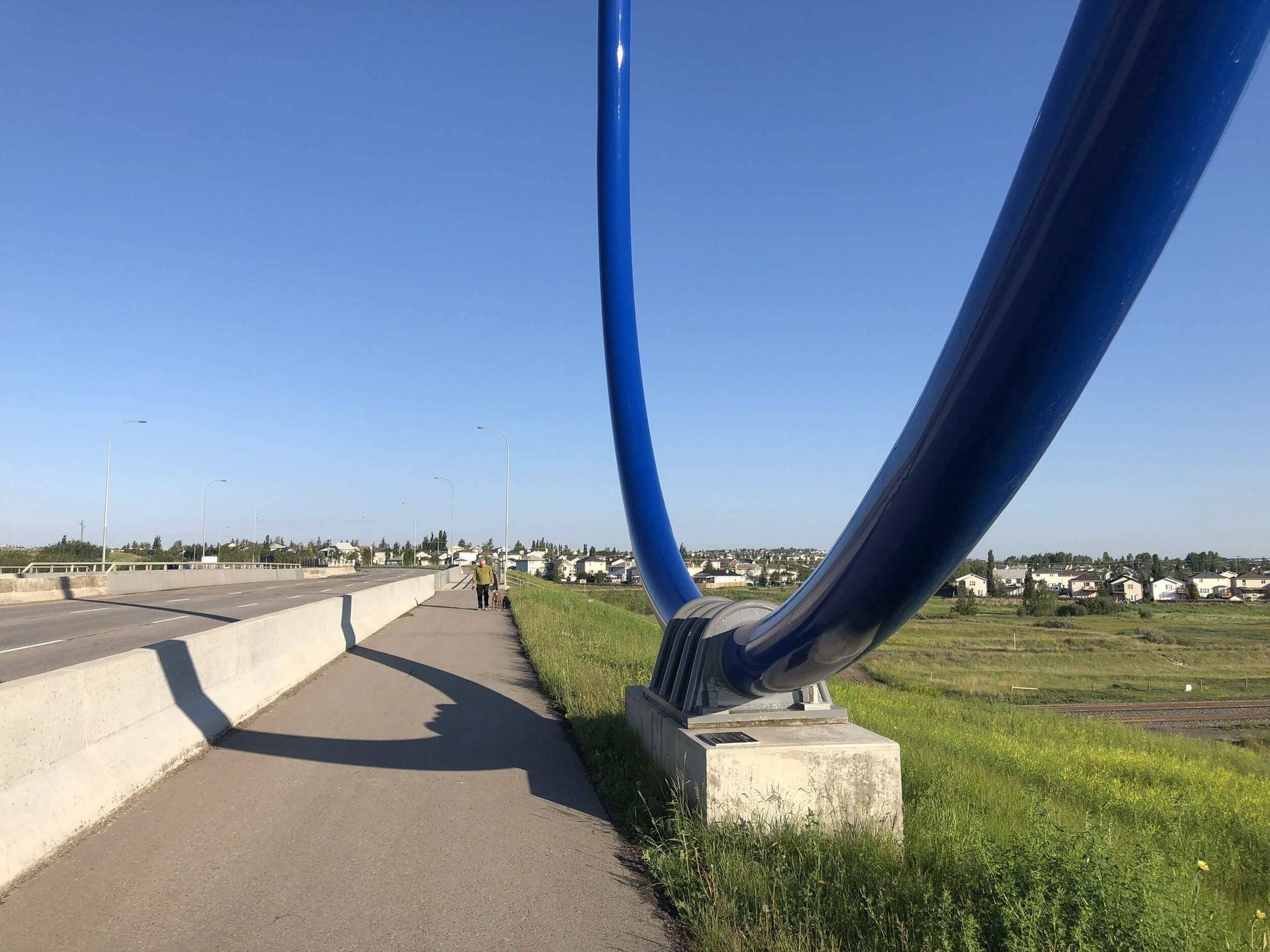
Sprawlcast Ep 6: Beyond the Big Blue Ring
A better way to discuss public art
In Sprawlcast Ep 6, Jeremy learns to love Traveling Light, Calgary’s most roundly-ridiculed piece of public art. Calgary artist Alana Bartol walks the city limits. This episode was partially recorded at a d.talks forum on public art in June, and also features Ciara McKeown, Iman Bukhari, Dan Jacobson and Michelle Reid. A full transcript is below.
Support the Sprawl so we can keep doing in-depth local journalism like this!
[SPRAWLCAST THEME]
JEREMY: Hey there. My name is Jeremy Klaszus and I’m the founder and editor of The Sprawl. You’re listening to Sprawlcast, which is a collaboration between The Sprawl and CJSW 90.9 FM. We are broadcasting/podcasting from Calgary on Treaty 7 land and we want to acknowledge the traditional territory of the people of Treaty 7.
I’m really happy to bring you our sixth episode: “Beyond the Big Blue Ring.”
JEREMY: Yesterday I was going through pictures on my iPhone because I needed to free up some space. You know how this is. You’ve got thousands of pictures on there. You need to decide which ones you actually need to keep. Well, there was one that I was going to delete, but didn’t—because I have, I’ve found, an unexpected affection for the subject.
The photo was of “Travelling Light,” a.k.a. the Big Blue Ring, the sculpture on 96th Avenue on the way to the airport. Now, maybe you have a photo like this on your phone, too, hastily snapped while speeding down the Deerfoot — I should say I was in a taxi, I wasn’t driving, so don’t get all worked up over that.

It’s interesting how local response to the sculpture has changed since it was first unveiled in 2013. Because back then it was roundly mocked and criticized and lambasted as a waste of money—and as a joke. Talk radio and the Calgary Sun had a heyday with it, and even Mayor Naheed Nenshi said he didn’t like it either.
He said it was “awful.”
But I don’t know. I think it’s kind of grown on me.
It’s become one of our family traditions that every time we drive by “Travelling Light” we point it out to the kids and we all have a laugh. And sure, it’s kind of funny-looking with its little antennae. But it’s part of how we experience the city now.
AXEL LIEBER: And we got mostly inspired, I’d say, by the background.
JEREMY: This is Axel Lieber. He’s one of four artists behind Inges Idee, the German collective that made “Travelling Light.” This is from a video on the City’s website.
LIEBER: The location has, like, really different views, so if you come from the other highway — I think it’s Deerfoot Trail, what it’s called — you can really see it from a long distance. You can see the bridge, and with that in mind, we tried to come up with something that you really can catch from … even also from a distance.
JEREMY: But then earlier this summer, I had a new experience of “Travelling Light.” I decided to bike to the airport, and the way there from my house goes right past the sculpture.
Now, I’m no art critic, but seeing it up close, I’ve got to say, I was impressed.
KENNETH HEINBECKER: What makes this an interesting sight is that we’ve got the regional pathway, but then we’ve also got the streetlights that are required as a part of the bridge — you know, equal distance spacing.
We’ve got a fairly nondescript overpass in a nondescript part of town — in the suburbs, for all intents and purposes — and all of a sudden we’ve got this universal, simple symbol that gives that bridge an identity.
JEREMY: This is Kenneth Heinbecker with Heavy Industries, the Calgary company that built “Travelling Light.” Now, he’s moved on from the company since, but this is from a talk that he gave at CreativeMornings in 2016.
HEINBECKER: What we did was we removed one of the streetlights and then replaced it with a new streetlight unlike anything you’ve ever seen before. Instead of it being a whole bunch of sticks, it’s now a whole bunch of sticks with a circle in the middle and then a whole bunch more sticks.
It gives this bridge identity.
You know, we’re not dealing with the Golden Gate Bridge here, or Lions Gate Bridge in Vancouver, or any one of a number of bridges that mark a town. We’ve got a fairly nondescript overpass in a nondescript part of town — in the suburbs, for all intents and purposes — and all of a sudden we’ve got this universal, simple symbol that gives that bridge an identity.
JEREMY: I took the obligatory selfie and then kept biking eastward, and I hadn’t even gone a few hundred metres and I encountered a couple of moose standing right by the bike path. It all made for a very memorable and surreal experience.
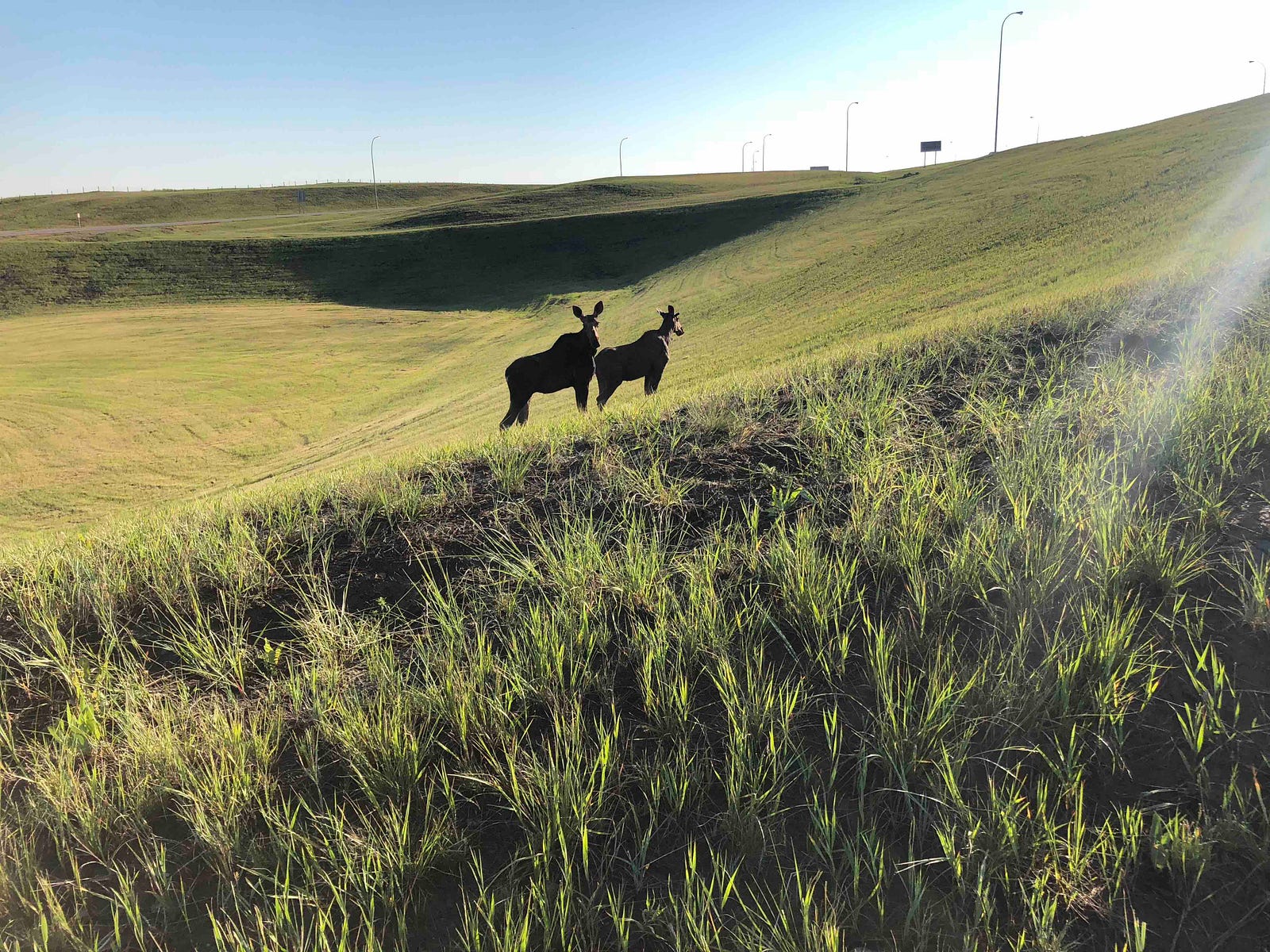
Here it was early on a Sunday morning; the city is quiet; I visit the sculpture; I am, in fact, “travelling light,” I must point out, because I’ve got everything on my bike; and then I run into moose. It’s something I’ll remember, and it wouldn’t be what it was without “Travelling Light.”
LIEBER: Our concern was that you make a sculpture that can be experienced also by people in very close contact, not only by the car. Mainly by the car and mainly in the distance, but also from other people around.
JEREMY: And I’m not the only one who’s done this. I keep seeing this on social media, people biking up to the sculpture to see “Travelling Light” up close.
So you heard it here first: “Travelling Light” is the new Peace Bridge.
Well, maybe not quite, but it has moved beyond being just a target for outrage.
And here I do have to give credit to whoever is behind the @GiantBlueRing Twitter account, because, surely, whoever is doing that account has helped to rehabilitate the image of this beleaguered sculpture.
Whoever it is is very funny, and I’ve actually been in Twitter negotiations with them to do an interview for a future episode of Sprawlcast, so we’ll see where that goes.
JEREMY: Today on Sprawlcast we’re talking about public art, because while we might not always do public art well in Calgary, we don’t often talk about it well either. We kind of let the Calgary Sun set the terms of the debate and go from there. It’s all about different controversies, and “is this a waste of money” and “why wasn’t a local artist chosen” and “why are we getting an artist from Spain or New York or Germany.”
Those are important questions, don’t get me wrong, but there are better ways to talk about this than just outrage and overreaction all the time.
And that’s where d.talks comes in. d.talks is short for Design Talks, and they’re a group that holds regular forums on architecture and design in Calgary. We’re going to listen in to a forum that they held on public art on June 7th. Here’s d.talks’ executive director, amery Calvelli.
AMERY CALVELLI: We’d really like to talk about public art as an investment in civic life: How can public art stretch our ability to connect with the people that live in this city?
JEREMY: There were four panelists, and I’m going to introduce them one by one and then let you hear their voice so you can tell who’s talking when we listen to the conversation. First up is Michelle Reid, and she’s the Cultural Landscape Lead with the City of Calgary.
MICHELLE REID: My primary job is to help Calgary Parks better manage their historic resources.
JEREMY: Dan Jacobson is an assistant professor in the University of Calgary’s geography department.
DAN JACOBSON: Hello. Good evening, and thank you for the opportunity to be here.
JEREMY: Iman Bukhari is CEO of the Canadian Cultural Mosaic Foundation.
IMAN BUKHARI: I’m a multimedia storyteller, so I studied technology communications and I absolutely love it, so that’s kind of like my full-time daytime job, but in the evening I like to explore my passion for race relations and arts.
JEREMY: And, Iman also hosts “Mosaic Talk” on CJSW. It’s all about race relations in Canada, so make sure to check that out.


And the fourth panellist was Alana Bartol. She’s a Calgary artist, and she talked about two projects that she worked on in recent years. One is the Orphan Well Adoption Agency, where people can actually adopt wells that have been abandoned by oil and gas companies.
And the other one was about exploring the city limits.
ALANA BARTOL: In my artwork, I’m really interested in how we relate to the land, the more-than-human world, and each other, and how this informs how we connect and relate to place.
Walking can be one of the best ways to get to know a place, so in the summer of 2016, I attempted to walk the city limits of Calgary, which is over 174 km, mapping the walk through collected objects, photographs, and video. This was a performance piece developed and commissioned by the Mountain Standard Time Performance Art Festival in Calgary.
The City of Calgary’s virtual map became my guide, and, through a series of diptych photographs, discarded items found along the edge of Calgary are paired with images of the places where they were found. They tell stories.
JEREMY: Let’s listen in to some of the discussion. It was moderated by Ciara McKeown, who’s a public art commissioner, curator, and project manager.
CIARA MCKEOWN: I thought I would start with a question around our evolving sense of the city.
In thinking about all the work that you’ve presented, the way that we’ve talked about and acknowledged the complexity of cities, of public spaces, knowing that these are constantly changing and shifting, how do we see art as part of that changing relationship to place—both in a personal and collective way, and just how can public art be part of our evolving sense of the city?
JACOBSON: I’m going to jump in. I think what’s very interesting is that there’s a very kind of rigid way that cities grow in terms of open planning, suburbs, etc., where they’re very laid out in a very regimented way. I think Calgary probably has some of the worst examples of that that I’ve almost ever seen in terms of both urban sprawl and the design of communities, where you go somewhere and it has a name and every road has the same name, but with “Way,” “Place,” “Court”—so you’re lost already to begin with.
But I think, perhaps, to counter that very formal way that cities are planned is an evolution of how they’re used and how people experience those places and how they’re, perhaps, beginning to change those places.
MCKEOWN: Anyone … Alana?
BARTOL: Yeah. Part of the walking project was speaking very much to that, right? Just how difficult it is to navigate the city or the ways that we might not think about navigating the city, or even how that perimeter gets defined and how we think about that in relation to who we are and how it reflects the values we want to have as a community, as a city.
If you’re continuing to build outwards, then you’re not making a very walkable city, so part of that project was even to make that kind of visible in another way.
I’d be walking for 10, 15 hours a day for 10 days, and each time I would try and take public transit back home, which is almost completely impossible because the edges of the city are pretty far out there, so sometimes I’d take public transit and then be walking for a couple hours just to get back to the point where I left off in the piece.
I think there are these kinds of things that come up through artists entering into processes to, maybe, just start with a couple of questions or an idea—but artists really reveal and sort of bring out all of these different ways of looking at the city where we live, the everyday experiences that we’re used to, just going from Point A to B or in our everyday routines. And so it gets really hard to open up and consider multiple perspectives. So I think artists are able to offer diversity of perspective, and, certainly, Iman, you were talking to that as well, right?
Artists really reveal and sort of bring out all of these different ways of looking at the city where we live, the everyday experiences that we’re used to.
BUKHARI: Yeah, I think it’s totally about that. It’s about storytelling and involving that community—and sometimes it may mean it’s a difficult conversation and that doesn’t mean it can’t evolve into something else, but as long as it’s involving that community and it’s going to come through that artist’s vision, which is the coolest part, where you’re talking to the community but it’s still going to come through the artist. So it’s building your city and it’s giving that identity.
Like, if I walk around and I see public art, I associate with it. It’s kind of like my identity as a Calgarian, kind of thing, where it’s like I’m walking and I feel like, okay, this is a part of my community, so it’s part of that design. It’s part of that environment, and it makes me feel more welcome, to be honest. And I love seeing that diversity within public art where it’s not just about that typical person, but rather that diverse community.
It makes me feel more welcome, to be honest.
REID: I think I already answered the question, but I think the great possibility of public art is that we do have places all across the city that people go to every day and they have this experience, and I think that sometimes people can zone out and they’re just walking along the bike path, just…
But I think that public art has the ability to make you stop and look a different way and have a different experience. It adds such a richness to it.
I’m sorry that I can’t remember the name of the artist or the name of the project who just put those questions about the river on the bike path [Ask The River by Broken City Lab]. Like, that’s incredible, because people commute there all the time and then you’re just like, oh, right. It can take you out … And that makes your experience of the city so much better.
MCKEOWN: Yeah, and thinking about … I think that idea of … Iman, as you said, about the artist’s intention and that concept being part of those conversations, right? So that it’s not just that the art is there, the concept is there, and then everything else happens here, but really about pairing that intention and coming from that place as an artist and really being able to have those conversations in an open way without you being told how those should happen, right?
I think that public art has the ability to make you stop and look a different way and have a different experience. It adds such a richness to it.
BARTOL: Yeah, and the pieces I talked about aren’t necessarily … They’re public art, but they’re not sculptural pieces. There’s different objects created, like photographs or video. There’s certainly many different components to the Orphan Well Adoption Agency which do result in more traditional forms of art, but I think that art can be that conversation you’re having.
Like, art is embedded in that process. A performance can be a public art piece as well, and so people that are brought into that experience in different ways, whether that’s through the artist’s research or having an artist embedded in a site and being able to communicate and connect with people in different ways. I think that all helps develop an awareness of how artists work and what art can be—and what that process is.
MCKEOWN: Yeah, and I think in terms of how, if we’re acknowledging that that city is always evolving, then that process allows for things to be open so that we know that it’s going to be constantly changing and yet the artist is constantly part of that responsive process, right?
You were going to say, Dan?
JACOBSON: I think that the really interesting thing is when detours happen, and that can be a detour in your thought about stopping by the river on one of the question marks there.
When you take a detour from your routine, it actually gives you the ability to think differently or to come across new ideas, new places. And I think art, in the same way — particularly public art — forces that kind of question. That when you see it, whether you scratch your head, whether it gives you a really warm feeling, but it certainly evokes emotion, which is very important, I think, in a city, rather than some — I don’t want to use the term “blank canvas,” but I just have — where there’s really nothing there.
It’s an integral part of who we are in our city.
When you take a detour from your routine, it actually gives you the ability to think differently or to come across new ideas, new places.
JEREMY: We’re going to move into questions from the audience, and the first question was about people who are diehard in their opposition to public art.
JACOBSON: Maybe I would comment that is the 20 percent of nonbelievers where your energy needs to be spent, and is it somewhat wasted energy? Unless they’re very vocal and very vociferous, is it much better to direct that question or rephrase that question and think about the 60 percent?
But to try and answer the actual question, I would posit, what if there was a city that had nothing that resembled art in any form? However you even consider that. So if you took down every advertising billboard, every shopfront sign, every road sign, until it became a completely gray, brutalist landscape, how would that then be? So then say, what would they like to see?
MCKEOWN: I think it’s not necessarily about converting nonbelievers, right? It’s about … We’re not getting projects out there to meet a percentage, to say, “We hope everybody likes it,” our job is done—and we close the book.
I think it’s about public art trying to continue a dialogue, and we’re not converting and we’re not hoping to meet consensus, maybe, but really just about, okay, let’s talk about issues in a way that’s interesting to people that can share all kinds of ideas about it. And really the art being part of that ongoing dialogue so that it’s not an acceptance base and it’s not necessarily saying, “We all have you converted to public art. You’re all on our side,” but really about that kind of way that we can share things in our city and share experiences.
So it’s not acceptance of, maybe, an object, or it’s not about a goal that we’re going to meet by percentage. I think maybe for me that feels like we want to just be able to have conversations and dialogues—and that would be successful.
I think it’s not necessarily about converting nonbelievers… I think it’s about public art trying to continue a dialogue.
BARTOL: Everyone experiences art in their everyday lives constantly, whether that’s a piece of writing like a story, entertainment … There’s all kinds of ways we consume and engage with and absorb art, so I think the idea of not believing and supporting art is …
We’re constantly supporting art, so I think it becomes a conversation, often, around value, which usually only gets defined through a monetary or a commercial or an economic lens, and so I think part of the conversation is really opening that up, those frameworks, and saying, well, what is the value of art? Why is it important to us as humans? How does it enrich a social context? How does it provide philosophical, aesthetic, critical experiences that enrich the way we think about things and experience things and feel things?
So yeah, I would like to talk to those people, because I think there’s a lot to say on the topic about why art is important and why we should support it, and there’s so many different artworks to point to that do that in so many ways.
And yes, not everyone is going to like everything, but this is something that we need to get behind and support as a community and as a city and as a country.
AUDIENCE #2: Hi. I’d like to talk about how public art is generated, birthed, how it comes to be in the first place.
So in Calgary we have the model of the City of Calgary’s public art department and the council that has made this commitment to make art happen in the city, but the way it happened is that we’ve got a budget based on something that was built and we’ve got a spot, and we need to find some art for that spot, sort of. That’s kind of how we do it.
Or we’ve got a corporation that buys something like “Wonderland” and puts it in the public realm of their building. Or we’ve got somebody in our neighbourhood who paints the garage door amazingly and we have to walk in the alley just to make sure we see it every day.
Only the last one addresses the artist’s need … the way art is made. How do we come up with public art that starts with the art so the artist, too, has this practice over time? What if they were asked to find a place in the city where their art might tell a story and work with a community and create a context and meaning in a place?
We don’t ever start with the art, and, somehow, all the ways we make public art happen seem antithetical to the way most art is made.
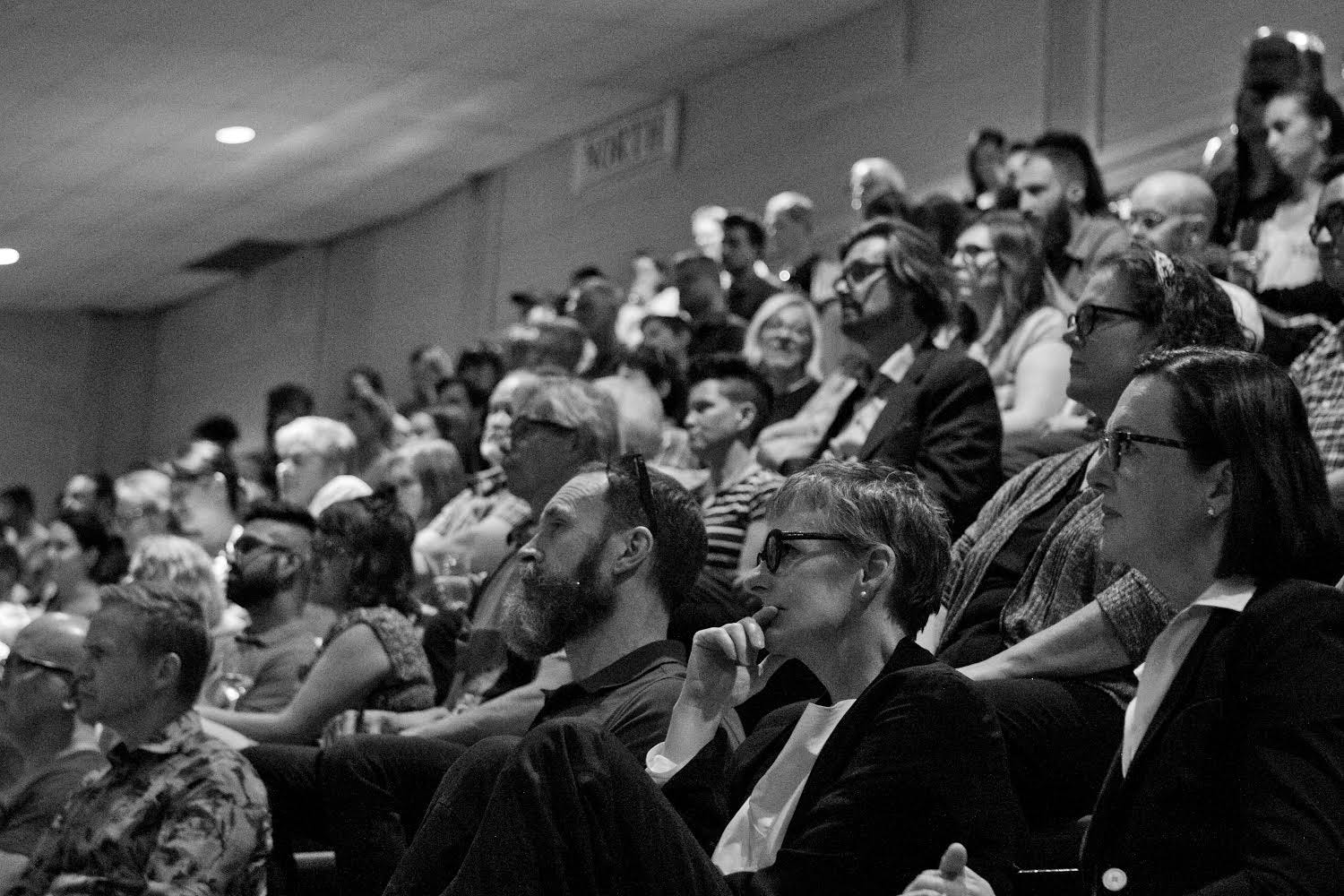
AUDIENCE: [clapping]
JACOBSON: I think that the last comment you made was so true. I’m not an artist, but it does all seem inverse. Yeah. I don’t really have much more to say on that other than it does need to be birthed, and birthed in lots of places, but how you do that I don’t quite know other than getting Banksy to appear here and suddenly emerge. I’m probably not the person to ask, so I’ll lower my mic again.
MCKEOWN: I guess to answer your question … and thank you for your question, and I’m trying to focus it on some bigger questions, and the details of all of these are quite complicated, and so many conversations we can have about it. But I think it’s that idea of the commissioning process, perhaps, is what you’re referring to, and how does the art begin. How do we define what that’s going to be, and how do we open up space for how that art happens?
Of course we can talk about details of how the funding happens and how we talk about where that funding is allocated and all of those details, but I really think creating an open process, potentially, is some of the things that we’ve all talked about this evening. And really thinking about if we’re evolving a sense of place and how are we thinking about our cities and our relationship to it through art.
And so maybe it’s partially about starting with an openness, and then the art and the ideas come from that because they’re evolving organically, but with intention, through a commission, right?
BARTOL: Yeah, and I think those projects have happened. Those types of projects are happening in Calgary, but maybe they’re not made as visible, unfortunately.
For example, well, the Watershed+ program. The model of having an artist residency or an artist-in-residence. I actually participated in a pilot project with the City of Calgary’s Public Art Program called Open AiR. There were three artists and we were able to work for three months in the old fire hall on Memorial Drive, and that residency was very open-ended, and it was really about allowing us to spend time in the community to think about particular questions we had posed.
But it wasn’t saying, “okay, this is going to be this sculpture in the end, or this piece.” It was sort of allowing us the time and space to really connect with people and explore some ideas.
And there’s another project that I did with the City of Calgary Public Art Program through the Community Cultural Development program which often gives smaller budgets tied to those larger 1% projects that you’re referring to, to allow artists to work with communities and in a process.
So there are those types of projects happening, but I agree that they’re not as widely known and they’re not celebrated in the ways that they should be. I think we need to get better at talking about those projects that are happening.
MCKEOWN: Iman, you wanted to jump in?
BUKHARI: Yeah, it’s completely a systemic issue, and it’s not just in Calgary, but in various other places, too. It’s just the way that we’ve built our societies, we’ve built our systems, we built our proposal systems or whatever it may be. It’s more focused on the process, or whatever you want to call it, rather than the artists or the art itself, and it’s just how government works.
Sometimes there’s a reason why it works like that, and I understand that, but sometimes I feel like there are bridges that we can connect where it can be about the art and the artists and their vision rather than following certain protocols and procedures.
But that does involve a lot of rethinking the way that we do things, which I know is very, very hard.
AUDIENCE #3: My question is specifically for Alana. I work in the field of architecture and urbanism, and I’ve often wondered, or had this question: do we really understand the boundary of where we live? Over the last six months or so I’ve been planning to walk the boundary of Calgary as well. I didn’t know about your work, so my question is, do you have any advice for me? Because I need it.
BARTOL: [laughs] Oh, yeah.
AUDIENCE #3: And just, given that you’ve already done the walk, is there something that you would like to elaborate on—or, if you were to do it again, what would you do?
BARTOL: Well, yeah. I’ve thought a lot, actually, about doing it again, or walking certain segments. Yeah, look for prairie dog holes when you’re walking, because there’s lots of them. It can be kind of dangerous in certain points because you’re walking along the side of the road. so that was something I didn’t… yeah, I just didn’t think about that, the danger element, and I think that really informed the direction the work went in. The wind is pretty wicked on the outskirts of the city, so be prepared. Bring lots of water. Yeah, we should talk more.
It really made me think about how restricted we are in our movements throughout cities and just how impossible it actually was to walk the city limits because most of it is on private property.
I can talk a lot more about that piece. I thought it was such an interesting work in so many ways because it really made me think about how restricted we are in our movements throughout cities and just how impossible it actually was to walk the city limits because most of it is on private property.
So that was part of a lot of my thinking around the history of Canada; the history of land division; being on Treaty 7 territory; how do I think about that as someone with a settler history; how do I think about safety, being a woman and walking alone; and thinking about the histories of colonial violence that are really present in the landscape that I kept being confronted with, really, through the walk.
AUDIENCE #3: Awesome.
BARTOL: We can talk more, but yeah. It’s a really transformative experience, I think.
[SPRAWLCAST THEME]
JEREMY: You’ve been listening to Sprawlcast, which is made at CJSW 90.9 FM in Calgary.
Our theme music is by Dan D’Agostino and Kenny Murdoch, and people really seem to like this song. People have suggested that we make it available for download to our members, so I think I’m going to do that.
Our voice of the CTrain in the intro and extro music is the legendary voice of the C-Train, Holly McConnell.
And thanks to Ximena Gonzalez at d.talks for getting us set up with recording the event last month. That recording was made on June 7th in the Victoria Pavilion on the Stampede grounds.
Thanks for listening, and see you next time.
Jeremy Klaszus is editor-in-chief of The Sprawl.
Transcript sponsored by Not Just Paint — Calgary kitchen cabinet refinishing.
Support the Sprawl so we can keep doing in-depth local journalism like this!
Support independent Calgary journalism!
Sign Me Up!The Sprawl connects Calgarians with their city through in-depth, curiosity-driven journalism. But we can't do it alone. If you value our work, support The Sprawl so we can keep digging into municipal issues in Calgary!
